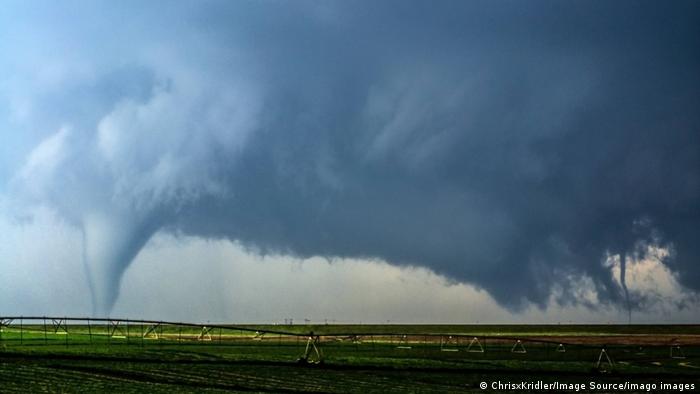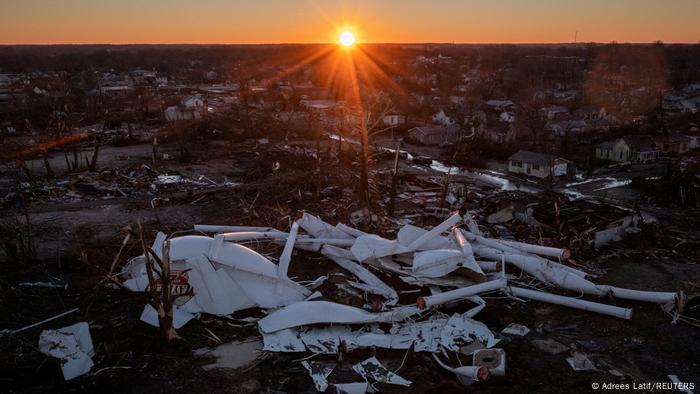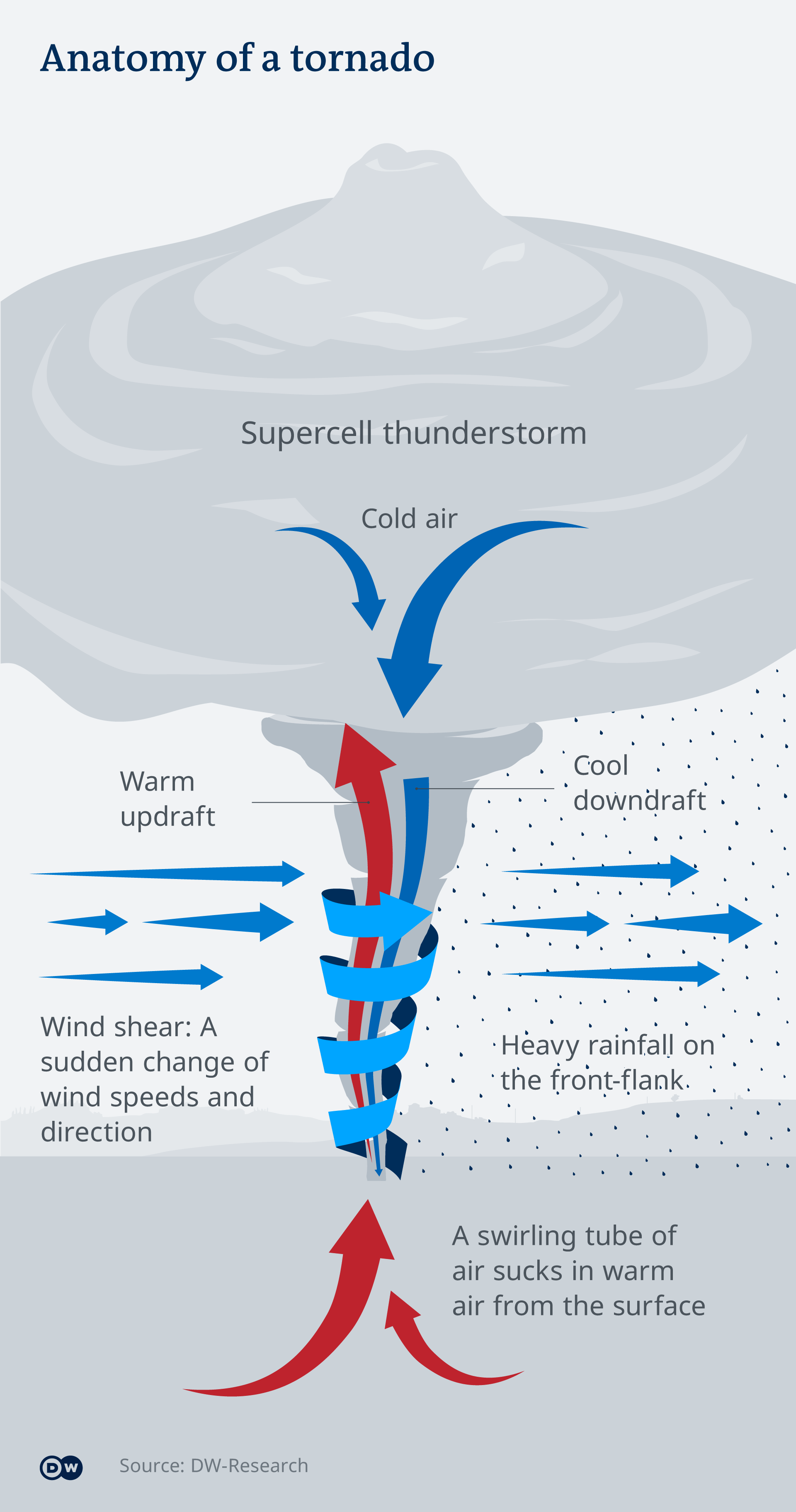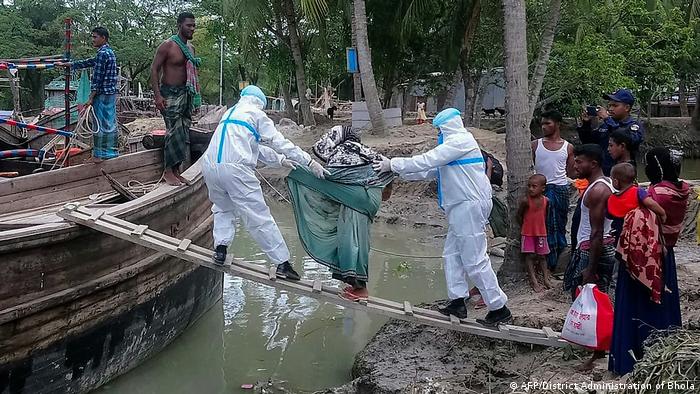Tornadoes can be destructive and hard to predict. We know why they form and that climate change can play a part — but we can't always see them coming. Here's why.

Supercell thunderstorms can produce more than one tornado at a time
Tornadoes can be terrifying — whether you experience them or only see images of the aftermath.
Most tornadoes are harmless and brief. But when a tornado falls outside the norm and collides with humans, it can cause severe damage and even death.
That is what happened when a series of tornadoes hit the United States in early December, leaving a trail of destruction from Arkansas to Kentucky. Dozens of people were killed and many are still missing.
The US National Weather Service described one of the tornadoes as "potentially historic" — due to it possibly being on the ground for the longest distance on record.

THOUSANDS STILL WITHOUT SHELTER AFTER US TORNADOES
Struggling to survive
A drone shot shows the extent of destruction: in Mayfield, Kentucky, the water tower collapsed like a house of cards. "Our infrastructure is so damaged. We have no running water. [...] Our wastewater management was lost, and there's no natural gas to the city. So we have nothing to rely on there,'' Mayor Kathy Stewart O'Nan told broadcaster CBS, adding that many people were struggling to survive.
123456
How does a tornado form?
Scientists know the basic ingredients for a tornado, but they are still trying to work out exactly what causes them.
"The truthful answer is we don't know," says Walker Ashley, an atmospheric scientist at Northern Illinois University.
Ashley is — what you might call — a storm chaser.
"I spend about a month and a half out of the year chasing these weather events, and they never want to [turn into a tornado] when I'm sitting there," Ashley told DW.

Specific weather conditions
Tornadoes form in very specific weather conditions. It usually starts with a kind of rotating thunderstorm called a supercell. A supercell can bring lightning, strong winds, hail and flash floods.
If the wind speed and its direction are different at different altitudes, you can then get a "wind shear."
Wind shears are often harmless but they can cause air currents to spin and create a horizontal tube of air. That's common in supercell thunderstorms, but it's not a tornado yet.
Sometimes a storm will suck up that tube of air until it becomes vertical. And when that happens it's called a mesocyclone.
That's still not a tornado. For a tornado to form, there also needs to be spinning air near the ground.
The stronger the tube of air rotates, the closer it can get to the ground and the more likely it is that it will turn into a tornado. Ashley says: Think of it like a figure skater.
"When a figure skater brings their arms out, they slow down. When a figure skater brings their arms in, they speed up," says Ashley. "And what a storm does is it takes that rotation, tilts it into the vertical and stretches it. And when it stretches it, it increases the rotation even more."
When that happens, gusts of warm air rise and gusts of cool air sink, blowing across the land. If there are enough rising and sinking gusts, the air near the ground starts spinning.
Once it's vertical, the tornado becomes darker. It picks up dust, debris and anything else that gets in its way. A really intense tornado will pick up cars, animals and even houses.
Why are tornadoes hard to predict?
Spring is considered to be tornado season in the US, but it can strike at any time, such as the ones in December 2021.
But they are hard to predict because compared to other extreme weather events, tornadoes are relatively small. That makes them difficult to observe.
"If we think about all the different hazards we have like hurricanes, droughts, floods, tornadoes might be one of the smallest," says Ashley, "even the most violent tornadoes are, at most, a half-mile (800 meters) wide — they occur typically in the order of seconds to minutes."
So, tornadoes often occur below particular levels that researchers generally use for observing, modeling and predicting weather events. Scientists can simulate tornadoes using computers, but "it requires an immense amount of computing power," says Ashley.
It's important to be able to predict extreme weather events so that authorities can issue warnings and give people a chance to get to safety. So, what do they do?
To issue warnings, scientists look out for supercell thunderstorms and use radar technology to measure how fast the mesocyclone is rotating. The faster it's rotating and the closer it is to the ground, the more likely it is that it will turn into a tornado.
"A majority of the storms and tornadoes [we observe] are on the cusp, like a storm is rotating like crazy in the mid-levels, but just because it's rotating up there doesn't necessarily mean it's going to come to the ground," says Ashley.
But researchers "don't have very good observations in the lowest levels of the atmosphere," says Ashley, and that seems to be a critical piece in the puzzle."
How does climate change affect tornadoes?
The role of climate change in tornadoes is complex. But Ashley says it's not a question of whether climate change causes tornadoes. The question is whether climate change contributes to the exact "ingredients" needed for tornadoes to form.
"As it relates to climate change, we know that some of the fundamental ingredients that [contribute to] severe thunderstorms and go on to produce hail and tornadoes are increasing," says Ashley.
And the modeling shows that that is particularly true in the United States, but it may also be happening in the UK and Europe.
Edited by: Zulfikar Abbany

CYCLONES, TYPHOONS, HURRICANES - THE POWER OF DEVASTATION
Social distancing impossible during Cyclone Amphan
Residents along Bangladesh's coast are being moved to safety as one of the strongest cyclones in years strikes the region. Millions of people had to be evacuated from low-lying regions along the Bay of Bengal on May 19. But plans are complicated by the coronavirus precautions. Maintaining social distancing is nearly impossible.
12345678910
Tornadoes form in very specific weather conditions. It usually starts with a kind of rotating thunderstorm called a supercell. A supercell can bring lightning, strong winds, hail and flash floods.
If the wind speed and its direction are different at different altitudes, you can then get a "wind shear."
Wind shears are often harmless but they can cause air currents to spin and create a horizontal tube of air. That's common in supercell thunderstorms, but it's not a tornado yet.
Sometimes a storm will suck up that tube of air until it becomes vertical. And when that happens it's called a mesocyclone.
That's still not a tornado. For a tornado to form, there also needs to be spinning air near the ground.
The stronger the tube of air rotates, the closer it can get to the ground and the more likely it is that it will turn into a tornado. Ashley says: Think of it like a figure skater.
"When a figure skater brings their arms out, they slow down. When a figure skater brings their arms in, they speed up," says Ashley. "And what a storm does is it takes that rotation, tilts it into the vertical and stretches it. And when it stretches it, it increases the rotation even more."
When that happens, gusts of warm air rise and gusts of cool air sink, blowing across the land. If there are enough rising and sinking gusts, the air near the ground starts spinning.
Once it's vertical, the tornado becomes darker. It picks up dust, debris and anything else that gets in its way. A really intense tornado will pick up cars, animals and even houses.
Why are tornadoes hard to predict?
Spring is considered to be tornado season in the US, but it can strike at any time, such as the ones in December 2021.
But they are hard to predict because compared to other extreme weather events, tornadoes are relatively small. That makes them difficult to observe.
"If we think about all the different hazards we have like hurricanes, droughts, floods, tornadoes might be one of the smallest," says Ashley, "even the most violent tornadoes are, at most, a half-mile (800 meters) wide — they occur typically in the order of seconds to minutes."
So, tornadoes often occur below particular levels that researchers generally use for observing, modeling and predicting weather events. Scientists can simulate tornadoes using computers, but "it requires an immense amount of computing power," says Ashley.
It's important to be able to predict extreme weather events so that authorities can issue warnings and give people a chance to get to safety. So, what do they do?
To issue warnings, scientists look out for supercell thunderstorms and use radar technology to measure how fast the mesocyclone is rotating. The faster it's rotating and the closer it is to the ground, the more likely it is that it will turn into a tornado.
"A majority of the storms and tornadoes [we observe] are on the cusp, like a storm is rotating like crazy in the mid-levels, but just because it's rotating up there doesn't necessarily mean it's going to come to the ground," says Ashley.
But researchers "don't have very good observations in the lowest levels of the atmosphere," says Ashley, and that seems to be a critical piece in the puzzle."
How does climate change affect tornadoes?
The role of climate change in tornadoes is complex. But Ashley says it's not a question of whether climate change causes tornadoes. The question is whether climate change contributes to the exact "ingredients" needed for tornadoes to form.
"As it relates to climate change, we know that some of the fundamental ingredients that [contribute to] severe thunderstorms and go on to produce hail and tornadoes are increasing," says Ashley.
And the modeling shows that that is particularly true in the United States, but it may also be happening in the UK and Europe.
Edited by: Zulfikar Abbany

CYCLONES, TYPHOONS, HURRICANES - THE POWER OF DEVASTATION
Social distancing impossible during Cyclone Amphan
Residents along Bangladesh's coast are being moved to safety as one of the strongest cyclones in years strikes the region. Millions of people had to be evacuated from low-lying regions along the Bay of Bengal on May 19. But plans are complicated by the coronavirus precautions. Maintaining social distancing is nearly impossible.
12345678910
No comments:
Post a Comment